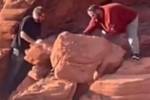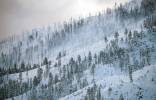Dumont Dunes provides unique recreation during cool months
Scouring the desert and mountains, wind gathers tiny sand grains and pushes the grains into drifts. Over time, when conditions are favorable, the gathered sand grows into shifting mountains several hundred feet high. In some places in the desert Southwest, vast dune deposits cover miles, taking on a life of their own. They form shapes such as stars or crescents. They even make sounds. All of them whisper as the sand moves, but some squeak or sing and a few actually boom as dry sand cascades from a high crest down the lee side.
Covering more than 8,000 acres south of Death Valley National Park, Dumont Dunes and nearby Little Dumont Dunes comprise an expansive recreational area administered by the Bureau of Land Management. Within view of Highway 127 between Shoshone and Baker, Calif., Dumont Dunes is open to off-highway vehicle use. Hundreds of enthusiasts arrive for scheduled events and unscheduled dune exploration during the cool seasons of the year, especially on weekends and holidays.
Dumont Dunes lies about 100 miles from Las Vegas. To reach the area, drive south on Interstate 15 to Highway 160, the road to Pahrump Valley. After driving over Mountain Springs Summit and down into the valley, watch for the turnoff onto the Old Spanish Trail Highway, a good paved route through Tecopa, Calif., to Highway 127.
Turn south on Highway 127 and drive a little more than 13 miles to Dumont Road, a rough, four-mile graded route crossing the course of the Amargosa River to reach the main dune field. Although a passenger vehicle will get you to the region, you'll need a high-clearance vehicle for this side road, especially if there is water flowing in the Amargosa, a strange stream that starts above Beatty, flows south partly underground, turns north and ends up in Death Valley.
After you cross the riverbed and climb out of the wash, you get your first good look at the dunes. The distant views from the highway do not prepare you for the immense sand mountains, the highest dunes in California with crests upwards of 500 feet high. The road ends near the base of the dunes where facilities include parking, pit toilets and informal campsites. Campers must bring water and metal-free firewood from home and carry all trash away with them. No glass containers are allowed.
Many visitors to Dumont Dunes do not use Dumont Road. If you continue about a mile beyond the turnoff to the side road, you'll reach a roadside campground and staging area for off-road vehicles near the Little Dumont Dunes.
From there, dune riders proceed to the sand mountains by whatever off-road conveyance they prefer -- ATVs, dune buggies, sand rails, four-wheel drive vehicles or motorcycles. Dumont dunes are among the few dunes that boom, but you'll be hard put to hear them over the noise of sand vehicles on a weekend.
Certain regulations apply to off-highway vehicles, including being equipped with tall masts and flags to let other dune riders know you are close. Riders must wear helmets. For more details on vehicle requirements, visit the BLM Web site at BLM.gov and search for Dumont Dunes or call the Barstow Field Office at (760) 262-6000. Related Web sites maintained by groups interested in off-roading also provide more information.
Visitors to Dumont Dunes must pay user fees that are site specific, ensuring funding for continuing maintenance.
For frequent users, an annual pass makes sense. Annual passes cost $90 for nonholiday use and $120 for use anytime, including holidays. Ask the BLM about annual passes and where to obtain them. Those who use the area less often pay for seven-day passes available on-site for $30 for nonholidays and $40 for weeks including a holiday.
January and February weekends and holidays mark the height of the season at Dumont Dunes for off-roaders.
On Jan. 30, Dumont Dune Riders presents an off-road regatta for the second year featuring events such as sand drags, day and night race courses and a show and shine. President's Day weekend in February usually promises more special events and thrilling rides.
Margo Bartlett Pesek's column appears on Sundays.




























